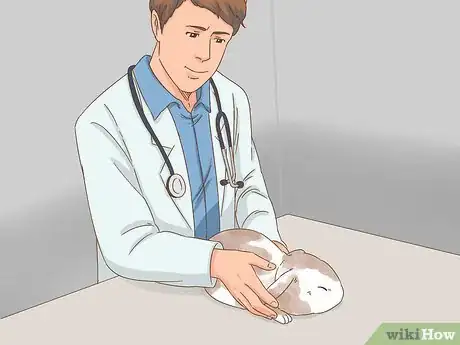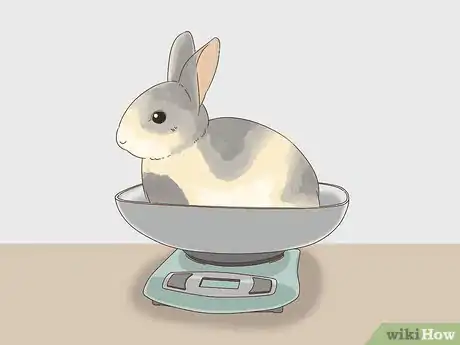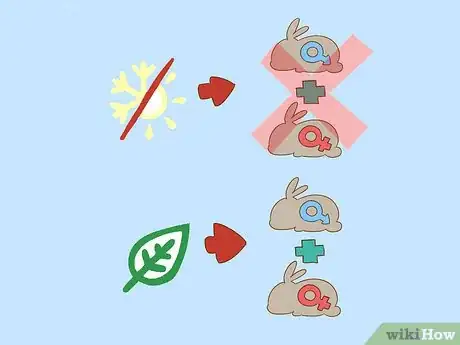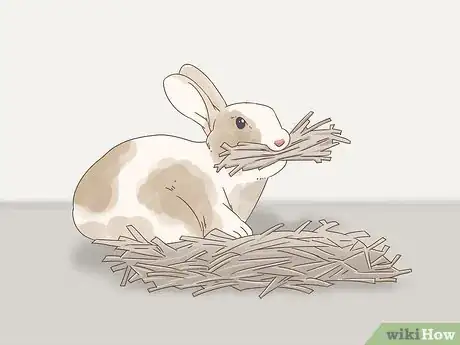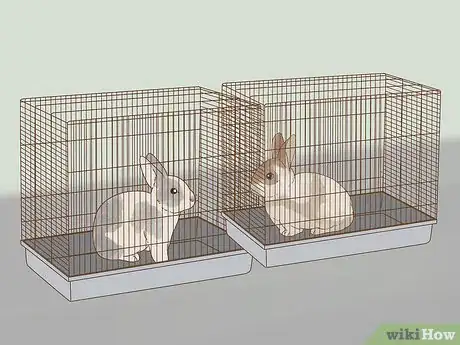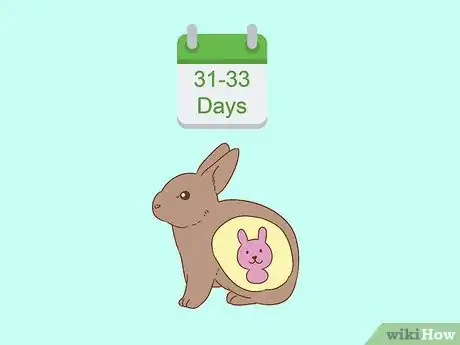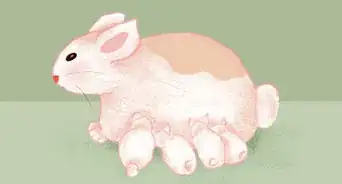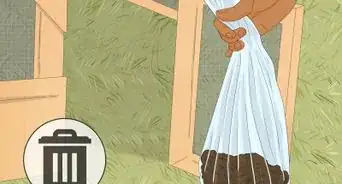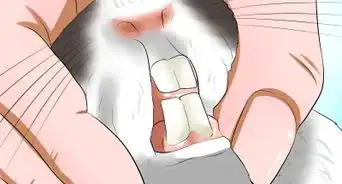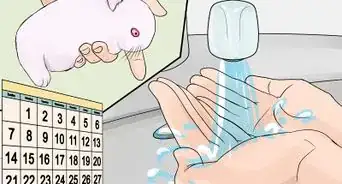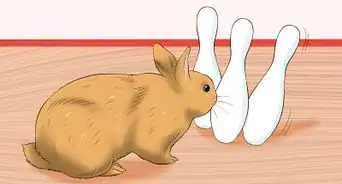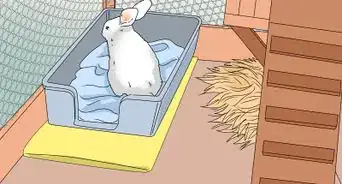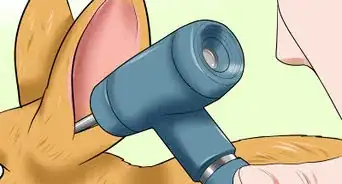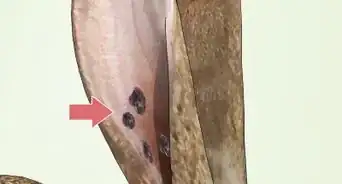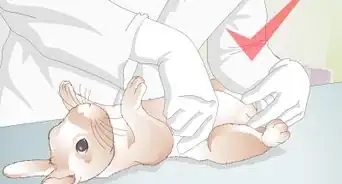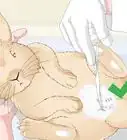This article was co-authored by Pippa Elliott, MRCVS. Dr. Elliott, BVMS, MRCVS is a veterinarian with over 30 years of experience in veterinary surgery and companion animal practice. She graduated from the University of Glasgow in 1987 with a degree in veterinary medicine and surgery. She has worked at the same animal clinic in her hometown for over 20 years.
wikiHow marks an article as reader-approved once it receives enough positive feedback. This article received 29 testimonials and 86% of readers who voted found it helpful, earning it our reader-approved status.
This article has been viewed 810,834 times.
Rabbits are wonderful animals that are bred for both companionship and for commercial purposes. Sometimes breeders don't fully know the history of a litter of rabbits, and may sell or adopt a rabbit to a new home without knowing whether the rabbit was spayed or neutered.[1] Whether you're trying to breed rabbits for yourself or have recently adopted a rabbit and fear it may be pregnant, knowing about rabbit physiology and how to check for signs of pregnancy can help you plan ahead and prepare for your rabbit's future.
Steps
Determining If Your Rabbit Is Pregnant
-
1Palpate your rabbit. Unless a female rabbit (also called a doe) is carrying a large litter, she will not show any external signs of pregnancy. That is why veterinarians and rabbit breeders palpate, or gently inspect (using the fingers or hands), the abdomen of a rabbit to determine if the rabbit is pregnant. Within two weeks of conception, you should be able to feel the young rabbits inside the mother rabbit's abdomen.[2] But knowing how to actually feel for the fetuses without injuring them takes some skill. This is merely a general guide, and if you are not a veterinarian or experienced animal breeder you should not attempt to palpate a pregnant rabbit on your own.
- Do not palpate a pregnant rabbit if it's been more than 14 days since the rabbit bred. Doing so may cause damage to the developing fetuses.
- Gently hold the rabbit's ears and a flap of shoulder skin in your right hand. This will secure the upper portion of the rabbit's body.[3]
- Use your left hand to gently cradle the rabbit's lower body, between the hind legs and the pelvis.[4]
- Gently place the thumb on the right side of the abdomen and the fingers of your hand on the left side. If the doe is pregnant, you should be able to feel the developing embryos inside her abdomen.[5]
- Each embryo should feel about the size of a grape.[6]
-
2Have a veterinarian palpate your rabbit. If you're unfamiliar with how to safely palpate an animal, it's recommended that you take your rabbit to the vet. Your vet will know how to safely inspect your rabbit without harming the fetuses.Advertisement
-
3Weigh your rabbit. A pregnant rabbit, much like a pregnant human, will gain weight during the pregnancy. However, that weight is not a large, noticeable difference. The best way to detect a rabbit's pregnancy by weight is to use an accurate digital scale and to compare that figure to your rabbit's weight before she became pregnant.
- A pregnant doe, on average, gains 0.029 kg (about 0.064 lbs) during the first week of pregnancy, and gains approximately 0.057 kg (0.126 lbs) by the end of the second week. After the second week, the doe's weight will not change noticeably.
-
4Have a vet conduct an ultrasound. An ultrasound is the best method to determine a rabbit's pregnancy, as it is 100% accurate after the first six days of gestation. Your vet can perform an ultrasound in his office to quickly and accurately determine whether your rabbit is pregnant.
Learning Rabbit Physiology
-
1Learn about rabbit life cycles. Most breeds of rabbits reach sexual maturity between three and six months of age. Female rabbits can conceive as early as 12 weeks of age, though this is generally not recommended for the health and safety of the rabbit.
- If your rabbit is younger than 12 weeks of age, she most likely is not pregnant. However, if she falls within the three to six month age range, she may have reached sexual maturity, and there is a chance that she could be pregnant.
- If your rabbit is older than two to three years of age, she may be too old to conceive. In this case, your rabbit most likely is not pregnant.
EXPERT TIPDr. Elliott, BVMS, MRCVS is a veterinarian with over 30 years of experience in veterinary surgery and companion animal practice. She graduated from the University of Glasgow in 1987 with a degree in veterinary medicine and surgery. She has worked at the same animal clinic in her hometown for over 20 years.Veterinarian
 Pippa Elliott, MRCVS
Pippa Elliott, MRCVS
VeterinarianPippa Elliott, a licensed veterinarian, urges caution: "Never rely on the rabbit being 'too old' to breed as a means of contraception. Rabbits are prolific breeders and nature has a habit of finding a way to boost the rabbit population!"
-
2Understand rabbit breeding tendencies. Rabbits are capable of breeding year-round, though fertility in males tends to decrease during extreme weather in winter and summer. Rabbits are most likely to conceive during the mild weather in spring or fall, though again, a rabbit is physically capable of conceiving at any time of year.
- Unlike many animals that go "into heat," rabbits are induced ovulators. This means that a female rabbit's body physically prepares for conception within eight hours of meeting a male rabbit.
-
3Look for signs of a nest. Female rabbits have a hard-wired instinct to build a nest when expecting offspring. An expecting rabbit will typically line her nest with fur, and she will become protective of her nest.[7] If your doe is building a nest, there's a chance that she may be pregnant. However, some female rabbits experience a "false pregnancy," in which the doe displays nesting behavior but is not actually pregnant. For this reason, nest building is not necessarily an accurate way to determine pregnancy, though it does suggest maternal instincts.
Preparing for the Litter
-
1Separate the female from all males. Once you know for certain that a doe is pregnant, it's important to keep her and all male rabbits separate. This is because a male could re-impregnate the female within mere hours after she gives birth. This can cause tremendous stress for the female, and make it impossible for the female to finish weaning her first litter before the second litter is born.[8]
- Some animal experts recommend trying to find a way to allow the male and female rabbits to interact without being in the same cage or hutch. This is because it may become difficult to reintroduce the two rabbits after the female has given birth if they are not properly socialized during the separation. If at all possible, try keeping their cages next to each other or allowing them to interact through a fence.[9]
- There is a chance that the male rabbit may try to mate with the female offspring he has fathered. Rabbit owners should keep the male and females completely separated to prevent this from happening.[10]
-
2Know the gestation period. Rabbits gestate for between 31 and 33 days. If the pregnancy goes on much longer than this, it may be a false pregnancy, or the litter may have died inside the doe. Some veterinarians recommend inducing labor after 32 days to prevent the risk of complications from the litter dying inside the mother.[11]
-
3Ensure that the doe is properly fed. If your rabbit is pregnant, it's important to ensure that she is getting enough food and water. Experts recommend gradually increasing the amount of food you give to a pregnant doe. You should also provide the doe with plenty of alfalfa hay, as this type of hay is very rich and provides the extra nutrients a pregnant or nursing doe will need.
Expert Q&A
-
QuestionWe put our male and female together two days ago, they had sex, and then we took the male out the same day. Today I tried petting the female and she bit me, does this mean she is pregnant?
 Pippa Elliott, MRCVSDr. Elliott, BVMS, MRCVS is a veterinarian with over 30 years of experience in veterinary surgery and companion animal practice. She graduated from the University of Glasgow in 1987 with a degree in veterinary medicine and surgery. She has worked at the same animal clinic in her hometown for over 20 years.
Pippa Elliott, MRCVSDr. Elliott, BVMS, MRCVS is a veterinarian with over 30 years of experience in veterinary surgery and companion animal practice. She graduated from the University of Glasgow in 1987 with a degree in veterinary medicine and surgery. She has worked at the same animal clinic in her hometown for over 20 years.
Veterinarian Not necessarily. She is probably feeling very territorial after the presence of the male.
Not necessarily. She is probably feeling very territorial after the presence of the male. -
QuestionCan boy rabbits have babies? My boy has just given birth.
 Pippa Elliott, MRCVSDr. Elliott, BVMS, MRCVS is a veterinarian with over 30 years of experience in veterinary surgery and companion animal practice. She graduated from the University of Glasgow in 1987 with a degree in veterinary medicine and surgery. She has worked at the same animal clinic in her hometown for over 20 years.
Pippa Elliott, MRCVSDr. Elliott, BVMS, MRCVS is a veterinarian with over 30 years of experience in veterinary surgery and companion animal practice. She graduated from the University of Glasgow in 1987 with a degree in veterinary medicine and surgery. She has worked at the same animal clinic in her hometown for over 20 years.
Veterinarian Oh dear, if a boy rabbit has babies then someone has gotten the gender wrong, and "he" is definitely as "she."
Oh dear, if a boy rabbit has babies then someone has gotten the gender wrong, and "he" is definitely as "she."
Warnings
- Have your vet's phone number on hand just in case something goes wrong during the pregnancy, birth, or afterward.⧼thumbs_response⧽
- Don't have the male in the cage when the female is giving birth. Females can become pregnant within hours of giving birth, and there's a chance the male may attempt to mate with the nursing female.⧼thumbs_response⧽
- Does may go through phantom pregnancies. A doe may build a nest, get labour pains, and end up not being pregnant at all. Consult with your vet if you believe your rabbit is in pain.⧼thumbs_response⧽
- Do not keep a buck with the kits. Once the kits reach sexual maturity, the buck may try to mate with his female offspring.⧼thumbs_response⧽
References
- ↑ http://www.bio.miami.edu/hare/surpriselitter.html
- ↑ http://www.fao.org/docrep/t0690e/t0690e0a.htm
- ↑ https://archive.org/stream/palpatingdomesti245suit/palpatingdomesti245suit_djvu.txt
- ↑ https://archive.org/stream/palpatingdomesti245suit/palpatingdomesti245suit_djvu.txt
- ↑ https://archive.org/stream/palpatingdomesti245suit/palpatingdomesti245suit_djvu.txt
- ↑ http://www.merckvetmanual.com/pethealth/exotic_pets/rabbits/breeding_and_reproduction_of_rabbits.html
- ↑ http://www.fao.org/docrep/t0690e/t0690e0a.htm
- ↑ http://www.bio.miami.edu/hare/surpriselitter.html
- ↑ http://www.bio.miami.edu/hare/surpriselitter.html
About This Article
If you think your rabbit might be pregnant, use your fingers and hands to gently inspect the rabbit's abdomen. To get the best position, use your left hand to gently cradle the rabbit's lower body, between the hind legs and the pelvis, and gently place your thumb on the right side of her abdomen and your fingers on the left side. If there are baby rabbits, they will be about the size of a grape. Be sure to weigh your rabbit to see if she's gained weight since breeding. If you're still not sure, take your rabbit to the vet to get her palpated and inspected for signs of pregnancy. For advice from our veterinary reviewer on the life cycle of rabbits, read on!

